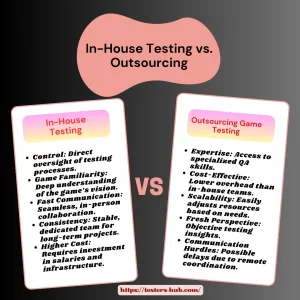Exploring the Cost of Game Testing Services
In the highly competitive realm of video game development, a game’s quality can significantly influence its overall success. With players expecting superior gameplay, stunning graphics, and immersive experiences, the role of game testing services has never been more critical. Developers must ensure their games deliver not only fun and engaging content but also operate smoothly without bugs or performance hiccups. This article examines the costs associated with game testing services and considers whether such an investment is beneficial for developers.
Understanding Game Testing and Quality Assurance
Game testing is an integral part of the video game development process. It focuses on systematically evaluating a game to uncover any defects, verify its functionality, and analyze the overall player experience before the game is launched. This critical step is essential for delivering a refined and enjoyable product to gamers. Quality assurance (QA) encompasses a diverse set of methodologies and techniques aimed at improving the game’s quality.
Role of Quality Assurance Game Testers
Quality assurance game testers play an integral role in the testing process. They meticulously evaluate various aspects of a game, including:
- Gameplay Mechanics: Ensuring all features function as intended.
- User Interfaces: Verifying that menus and controls are intuitive and responsive.
- Performance Metrics: Assessing load times, frame rates, and overall performance.
The goal of QA is not just to identify bugs but to improve the overall quality of the game, leading to better player satisfaction and retention.
Cost Factors in Game Testing
The costs associated with game testing services can vary significantly based on several factors:
1. Scope of the Project
Larger, more complex games will typically require more extensive testing efforts. The scope includes the number of features, characters, levels, and overall game mechanics.
2. Testing Methodology
Manual testing often incurs higher costs due to the labor-intensive nature of the process. Conversely, while automated testing can be more cost-effective in the long run, it requires upfront investment in tools and technology.
3. Geographical Location
The location of the testing team can impact costs. Companies in regions with a lower cost of living may offer more competitive rates for game testing services.
4. Level of Expertise
Experienced game QA companies and quality assurance game testers with specialized skills may charge higher fees. However, the quality of service they provide often justifies the cost.
5. Timeline
Strict deadlines can require extra resources or overtime, resulting in higher costs. To help control these expenses, it’s beneficial to incorporate testing early in the development process.
Return on Investment (ROI) in Game Testing
Investing in game testing services can provide a substantial return by addressing potential issues before a game’s launch. Here are several key advantages:
- Fewer Bugs
Detecting and resolving bugs prior to launch significantly decreases the chances of negative player experiences, which in turn reduces the necessity for expensive patches and updates after the game is released. - Enhanced Player Experience
Games that are of high quality tend to garner positive feedback from players, leading to improved reviews and higher sales. A thoroughly tested game is better positioned to meet player expectations, generating favorable word-of-mouth recommendations. - Stronger Brand Reputation
Consistently delivering high-quality games builds trust and loyalty among players, resulting in repeat business and a solid brand reputation.
4. Cost Savings
Addressing post-launch issues can be significantly more expensive than investing in thorough QA testing upfront. Proactive testing saves developers time and resources in the long run.
In-House Testing vs. Outsourcing
When considering game testing, developers often face the decision of maintaining in-house testing teams versus outsourcing to specialized game QA companies. Each approach has its own advantages and disadvantages.
In-House Testing
- Pros:
- Direct control over the testing process.
- Familiarity with the game and development team.
- Easier communication and collaboration.
- Cons:
- Higher overhead costs, including salaries and training.
- Limited expertise in specialized testing areas.
- Potential resource constraints for smaller studios.
Outsourcing
- Pros:
- Access to a wider pool of expertise and specialized knowledge.
- Cost-effective solutions, especially for smaller developers.
- Flexibility to scale testing efforts based on project needs.
- Cons:
- Less direct control over the testing process.
- Potential communication challenges, especially with remote teams.
- The need to invest time in onboarding and integration.
Long-Term Benefits of Game QA Services
Investing in game QA services provides several long-term benefits that enhance a game’s overall success:
- Minimized Post-Launch Updates
Conducting thorough testing before the game’s release decreases the frequency of necessary updates, allowing developers to redirect their focus toward upcoming projects instead of resolving prior issues. - Improved Player Retention
Games that deliver a smooth and engaging experience tend to retain players more effectively over time, leading to a loyal and enthusiastic fan base.
3. Increased Revenue
A well-tested game can lead to higher sales and revenue, as satisfied players are more likely to recommend the game to others and invest in additional content.
4. Continuous Improvement
Ongoing collaboration with QA teams allows developers to identify areas for improvement and implement feedback, leading to better future releases.
Real-World Case Studies
Example: “Cyberpunk 2077”
The launch of “Cyberpunk 2077” serves as a cautionary tale about the consequences of insufficient game testing. The game faced numerous bugs and performance issues upon release, leading to widespread criticism, refunds, and even a temporary removal from digital storefronts. Extensive QA testing could have identified these issues before launch, preventing significant damage to the game’s reputation.
Example: “The Last of Us Part II”
In contrast, “The Last of Us Part II” received critical acclaim for its polished gameplay and storytelling. The developers invested heavily in QA testing, ensuring a smooth launch and minimal post-launch issues, leading to positive player experiences and strong sales.
Cost of Poor Quality
Releasing a game that is plagued by bugs or quality concerns can result in significant financial and reputational consequences. These can include:
- Negative Feedback
Players are quick to express their opinions online. Unfavorable reviews can discourage potential customers and negatively impact the game’s reputation. - Refund Requests
A high number of bugs may prompt players to request refunds, which can lead to decreased revenue for the developer. - Increased Customer Support Costs
Games with quality issues often require more customer support to handle player complaints, putting additional pressure on resources. - Damage to Brand Image
A history of releasing problematic games can tarnish a developer’s brand, eroding trust and loyalty among players.
Future Trends in Game Testing Costs
As technology advances, the field of game testing is undergoing significant transformation. Here are some emerging trends that could influence the costs associated with game testing services:
- Artificial Intelligence and Machine Learning
Incorporating AI and machine learning into the game testing process can optimize testing efficiency and potentially lower costs over time. Automated tools are capable of swiftly detecting bugs and performance issues, leading to quicker turnaround times. - Remote Testing
The growth of remote work has paved the way for distributed QA teams, offering cost-effective solutions without the need for a physical office space. - Subscription-Based Services
Several game testing firms are implementing subscription models, enabling developers to access continuous testing services at a fixed cost. This approach can facilitate more effective budgeting for QA initiatives. - Heightened Emphasis on Player Experience
With rising player expectations, developers will need to allocate more resources to QA services that focus on user experience, resulting in higher-quality games and, consequently, increased costs.
Conclusion
Investing in game testing services is essential for achieving success in game development. Although there are costs associated with quality assurance, the long-term advantages significantly surpass the initial expenses. By ensuring that their games adhere to high-quality standards, developers can improve player satisfaction, establish a solid brand reputation, and ultimately boost sales.
Whether opting for in-house QA teams or collaborating with leading game testing companies, emphasizing quality assurance is vital in today’s competitive gaming environment. With a strategic approach to game testing, developers can create outstanding gaming experiences that resonate with players and endure over time.











